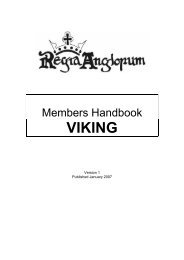Members Handbook - Norman - Regia Anglorum
Members Handbook - Norman - Regia Anglorum
Members Handbook - Norman - Regia Anglorum
You also want an ePaper? Increase the reach of your titles
YUMPU automatically turns print PDFs into web optimized ePapers that Google loves.
<strong>Regia</strong> <strong>Anglorum</strong> <strong>Members</strong> <strong>Handbook</strong> - <strong>Norman</strong><br />
Women’s clothing:<br />
Next to the skin, was the chemise, often soft and fine and sometimes pleated<br />
and laced at the side. It was intended to be displayed at the neck and wrist<br />
probably with fine embroidery on show. The outer dress worn either as a house<br />
dress or at court was the chainse; made of linen and pleated. A bliaut was an<br />
elaborate dress of costly material with bands of embroidery at the neck and<br />
cuffs. It was adjusted to the figure by means of lacing at the side, the sleeves<br />
were wide and long so they almost touched the ground.<br />
The wealthier women had fine tight sleeves on their shirts and these were<br />
prominent, extending to the wrist. Women of lesser status carried the sleeves<br />
of their bliaut to the wrist. Women habitually wore a double belt of cloth with<br />
long ties instead of a buckle in order to make their bliaut fit more snugly above<br />
the waistline; it became fashionable to slash the chainse from the armpit to the<br />
waist; these openings were laced permitting a little of the bare flesh to show.<br />
Relaxing at home a lady might wear her fur pellice with or without a chainse<br />
underneath.<br />
For both sexes the mantel was an integral part of the costume of a person of<br />
rank. It was a statement of your nobility. It was a most costly and sumptuous<br />
garment made of the richest materials, embroidered and lined with fur. It was<br />
fastened in front by costly brooches or by ataches (ribbons of silk).<br />
The chape was a wide cape with a hood, worn by both sexes and all classes on a<br />
journey, for protection against the weather. While lower classes are shown<br />
wearing the chape, they are not shown wearing the mantel. Towards the end of<br />
the C12th the mantel was removed in the presence of a person of higher rank.<br />
Jewellery was worn. Giraldus writes of a mantel fastened with a gold pin;<br />
earrings, a necklace, rings, set with stones, on fingers, and a golden band around<br />
the hair. Bracelets or armillae were frequently worn, as were necklaces or<br />
torques and earrings.<br />
Women kept their hair parted in the middle with two long plaits dropping as far<br />
to the ground as possible. The braids were plaited or the strands could be<br />
intertwined with ribbon. A band around the forehead or a cap held the hair in<br />
place. A wimple, an oval or circular veil would cover the hair and was pinned on to<br />
a headband or cap leaving the neck visible. Ladies used white powder and<br />
vermilion colouring on their faces.<br />
Page 22 of 32 Copyright © <strong>Regia</strong> <strong>Anglorum</strong> 2007



